This pub is closed permanently. Your nearest Wetherspoon pub: Goldengrove, Stratford
The name of this pub recalls Sir John Pelly, the governor of the Hudson Bay Company. Created First Baronet of Upton, by Queen Victoria, in 1840, Sir John was one of the leading landowners in the area during the late 18th and 19th century. The Hudson Bay Company originated in a royal charter, granted by Charles II, in 1670. The new company made great profits from importing, into Britain, furs and skins obtained by barter from North American Indians.
Framed prints and text about The Hudson Bay.
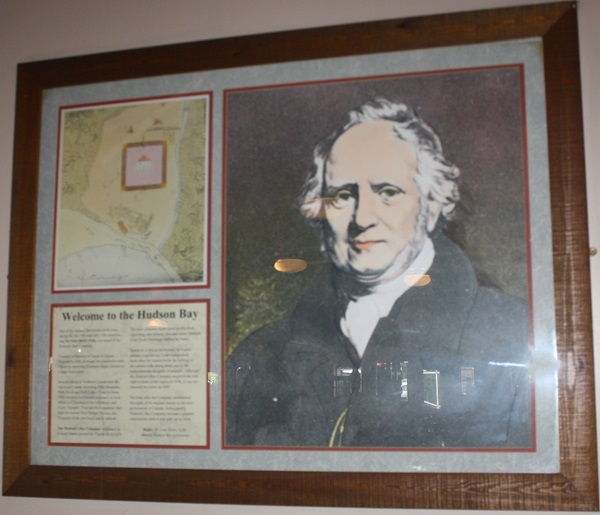
The text reads: One of the leading landowners in the area during the late 18th and early 19th centuries was Sir John Henry Pelly, Governor of the Hudson’s Bay Company.
Created 1st Baronet of Upton by Queen Victoria in 1840, he began his connection with Upton by marrying Elizabeth Hinde, heiress to a large local estate.
Several places in Northern Canada bear the Governor’s name, including Pelly Mountain, Pelly River and Pelly Lake. Closer to home Pelly exerted considerable influence in local affairs as Chairman of the Middlesex and Essex Turnpike Trust and the committee that was the second Bow Bridge. He was also Treasurer of the two local charity schools.
The Hudson Bay Company originated in a royal charter granted by Charles II, in 1670. The new company made great profits from importing, into Britain, furs and skins obtained from North American Indians by barter.
However, it was to be hit hard by French military expeditions. Later competition from other fur traders led to the bribing of the Indians with strong drink and to the indiscriminate slaughter of animals. Although the Hudson’s Bay Company acquired the sole right to trade in the region in 1838, it was not renewed in expiry in 1859.
Not long after, the Company surrendered the rights of its original charter to the new government of Canada. Subsequently Hudson’ Bay Company became a gigantic corporation, until it was split up in 1930.
Right: Sir John Henry Pelly
Above: Hudson Bay settlement.
An old Canadian map, showing where The Hudson Bay Company’s products were exported and imported.
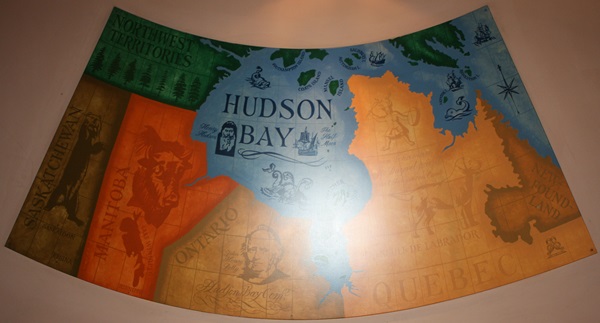
A framed print of the mouth of the Coppermine River.
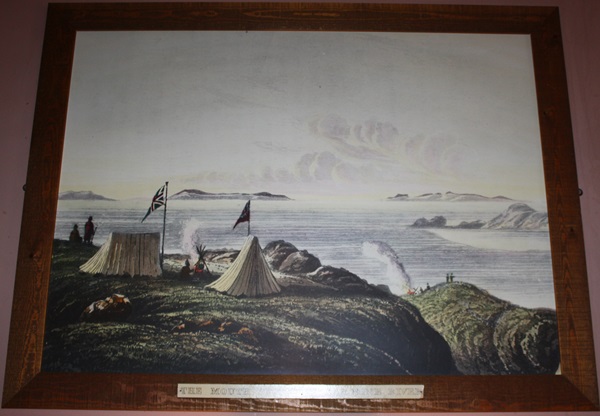
A framed print of the discovery of the Coppermine River.
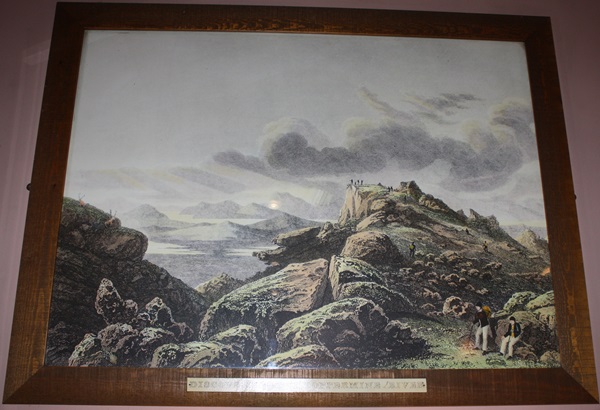
Framed prints, illustrations and text about the Gurney family.

The text reads: In 1812 Samuel Gurney, a member of the famous Quaker banking family, and himself renowned as a philanthropist, inherited the Ham House estate from his father-in-law, who had purchased it in 1787 from the Quaker physician John Fothergill. Fothergill had lived there since 1762, when it was Upton House, and had developed the grounds into a botanical rival to Kew, with 3400 species of tropical plants. The house remained a family residence until 1852, until the estate, along with others owned by the Gurney family, was broken up and sold for property development. The western part of the estate became the West Ham and Jewish cemeteries for the Forest gate Industrial School. The remainder became the Gurney housing estate, comprised of Harnfrith, Atherton, Norwich, Sprwoston and Clova Roads, as well as Earlham Grove. The Gurneys were linked by marriage to other banking families, the Barclay’s and the Lloyd’s, that became dominant high street names. Members of the Gurney family were prominent in banking, politics, social reform, theology and natural science.
Elizabeth Fry (1780-1845), the Quaker Minister and Prison Reformer, was Samuel Gurneys sister and lived for many years in Upton Lane House, which was known as the Cedars, on the estate.
Top: centre, Samuel Gurney as a young man, left, Plashet House, another local Gurney property, right, Upton Lane House, birthplace of Elizabeth Fry, lower left, Elizabeth Fry (nee Gurney) lower right, Samuel Gurney
Above: Ham House
Right: Samuel Gurney.
Framed photographs and text about John Curwen.
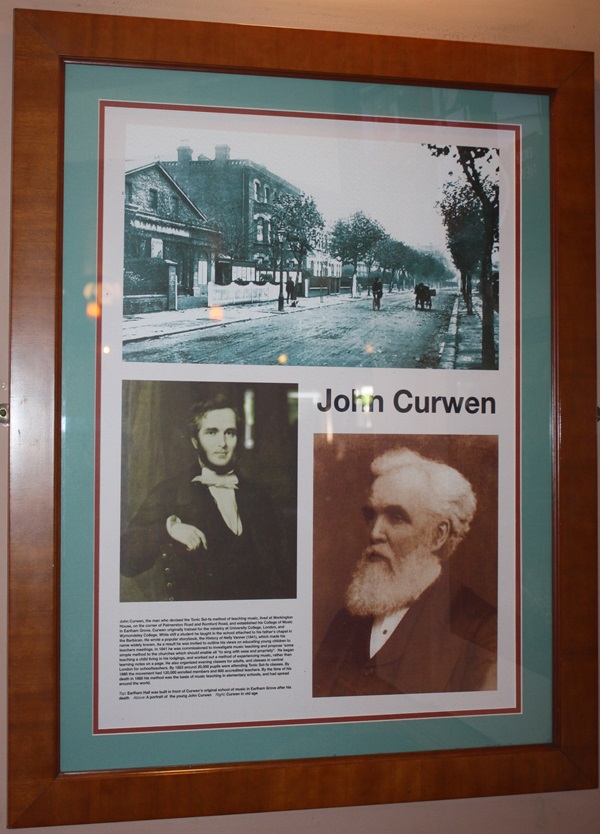
The text reads: John Curwen, the man who devised the Tonic Sol-fa method of teaching music, lived at Workington House, on the corner of Palmerston Road and Romford Road, and established his College of Music in Earlham Grove. Curwen originally trained for the ministry at University College, London, and Wymondeley College. While still a student he taught in the school attached to his father’s chapel in the Barbican. He wrote a popular storybook, the History of Nelly Vanner (1841), which made his name widely known. As a result he was invited to outline his views on educating young children to teachers meetings. In 1841 he was commissioned to investigate music teaching and propose ‘some simple method to the churches which should enable all “to sing with ease and propriety”. He began teaching a child living in his lodgings, and worked out a method of experiencing music, rather than learning notes on a page. He also organised evening classes for adults and classes in central London for schoolteachers. By 1853 around 20,000 pupils were attending Tonic Sol-fa classes. By 1860 the movement had 120,000 enrolled members and 600 accredited teachers. By the time of his death in 1880 his method was the basis of music teaching in elementary schools, and had spread around the world.
Top: Earlham Hall was built in front on Curwen’s original school of music in Earlham Grove after his death
Above: A portrait of the young John Curwen
Right: Curwen in old age.
Framed photographs and text about Upton Lane, at the heart of a Victorian suburb.
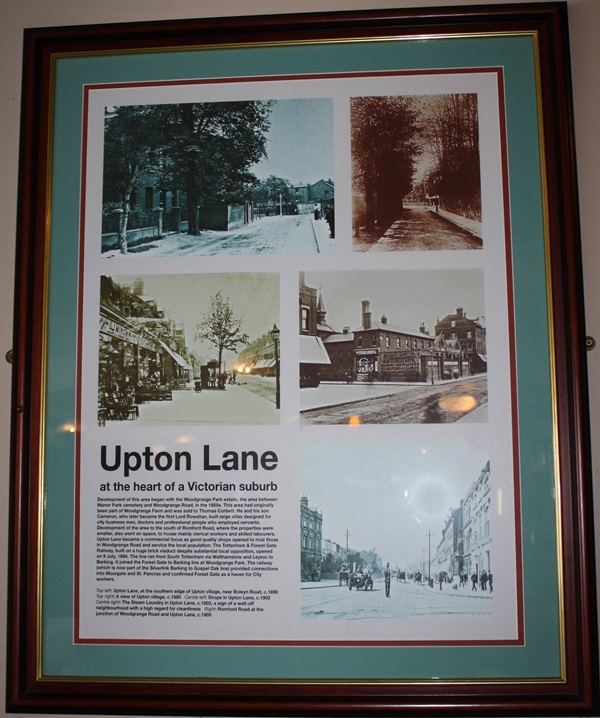
The text reads: Development of this area began with the Woodgrange Park estate, the area between Manor Park cemetery and Woodgrange Road, in the 1850s. This area had originally been a part of Woodgrange Farm and was sold to Thomas Corbett. He and his son Cameron, who later became the first Lord Rowallan, built large villas designed for city business men, doctors and professional people who employed servants. Development of the area to the south of Romford Road, where the properties were smaller, also went on apace, to house mainly clerical workers and skilled labourers. Upton Lane became a commercial focus as good quality shops opened to rival those in Woodgrange Road and service the local population. The Tottenham and Forest Gate Railway, built on a huge brick viaduct despite substantial local opposition, opened on 9 July 1894. The line ran from South Tottenham via Walthamstow and Leyton to Barking. It joined the Forest Gate to Barking line at Woodgrange Park. The railway (which is now part of the Silverlink Barking to Gospel Oak line) provided connections into Moorgate and St. Pancras and confirmed Forest Gate as a haven for City workers.
Top left: Upton Lane, at the southern edge of Upton village, near Boleyn Road, c.1890
Top right:: A view of Upton village, c.1880
Centre left: Shops in Upton Lane, c.1902
Centre right: The Steam Laundry in Upton Lane, c.1903, a sign of well-off neighbourhood with a high regard for cleanliness
Right: Romford Road at the junction of Woodgrange Road and Upton Lane, c.1905.
Framed photographs, painting and text about Lord Lister.

The text reads: Joseph Lister, the ‘father of antiseptic surgery’, was born at Upton House in Upton Lane in 1827. He graduated in medicine from London University in 1852, and became house surgeon at Edinburgh Royal Infirmary under James Syme, who became his father-in-law in 1856. In the 1860s, under the influence of Louis Pasteur’s theory that decay was cause by living organisms, Lister began to experiment by cleaning, and dressing wounds with carbolic acid. Later he opted for boracic acid, spraying it around the operating area. As Professor of Clinical Surgery at King’s from 1877 till 1893, Lister introduced an antiseptic system which changed the practice of medicine and drastically reduced mortality rates from major operations. Lister was the first surgeon to become a peer (in Queen Victoria’s Jubilee Honours list of 1897). He was a member of the King’s College Council and a life governor of the College. Lister’s principle, that bacteria must never gain entry to an operation wound, remains the basis of surgery today.
Top left: Joseph Jackson Lister, Lord Lister’s father
Top right: Upton House, painted by his sister, Mary, c.1835
Above: Joseph Lister aged 28
Right: Lord Lister aged about 40.
Framed photographs and text about Trebor.
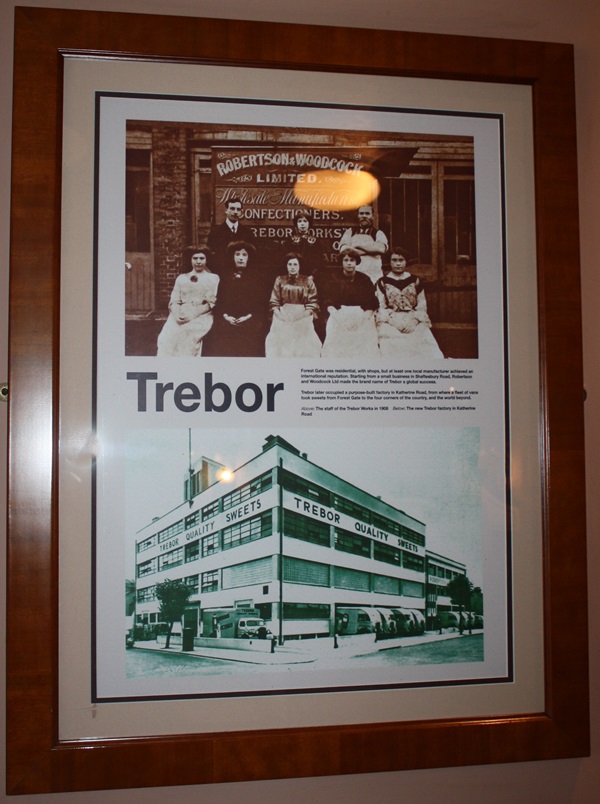
The text reads: Forest Gate was residential, with shops, but at least one local manufacturer achieved an international reputation. Starting from a small business in Shaftesbury Road, Robertson and Woodcock Ltd made the brand name of Trebor a global success.
Trebor later occupied a purpose-built factory in Katherine Road, from where a fleet of vans took sweets from Forest gate to the four corners of the country, and the world beyond.
Above: The staff of the Trebor Works in 1908
Below: The new Trebor factory in Katherine Road.
Photographs and text about one of Forest Gate’s most famous adopted sons - Arnold Schwarzenegger.
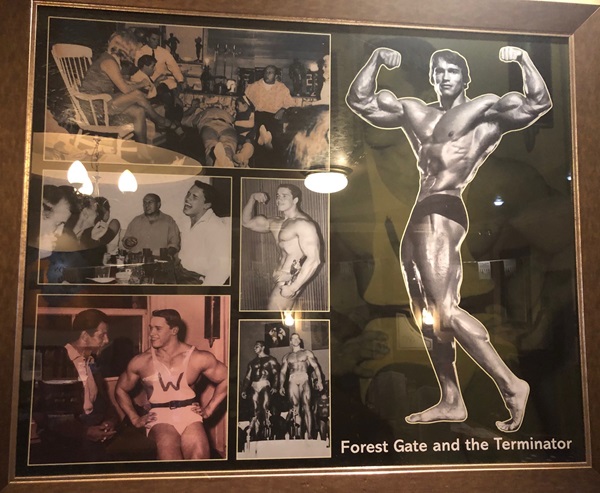

In 1966 ‘Arnie’ was here at the invitation of Wag Bennett, whose two gyms were at the centre of UK bodybuilding. The invitation included living with Wag and his wife Dianne: “They had six kids of their own, they took me under their wing and became like parents to me”.
Their home was on Romford Road, opposite Emmanuel’s church. Wag taught the young Arnie how to make a posing routine effective, “hypnotise and carry away an audience…how to slow down and make it like ballet”. Wag introduced music to the routes: “after a while I started to see how I could choreograph my moves and ride the melody like a wave”.
Meanwhile Dianne fed him with protein and ‘improved his manners’. She “got mad at me when she saw me shove my way through a crowd of fans after a competition”. She told him “these are people who came to see you. They spent their money and some of them travelled a long way. You can take a few minutes and give them your autograph”. Arnie recalled: “that scolding changed my life. I’d never thought about the fans, only about my competitors. But from then on, I always made time for the fans”.
Arnie became the youngest winner of the Mr Universe title in London in 1967, and after that Forest Gate dropped out of his story. He went on from body-building to Hollywood stardom, a marriage into the Kennedy family and then the governorship of California. But he remained close with the Bennett’s, and Wag was with him to celebrate his election as Governor of California in 2001.
A framed painting entitled Resident, by Neil Bailey, created in January 1999.
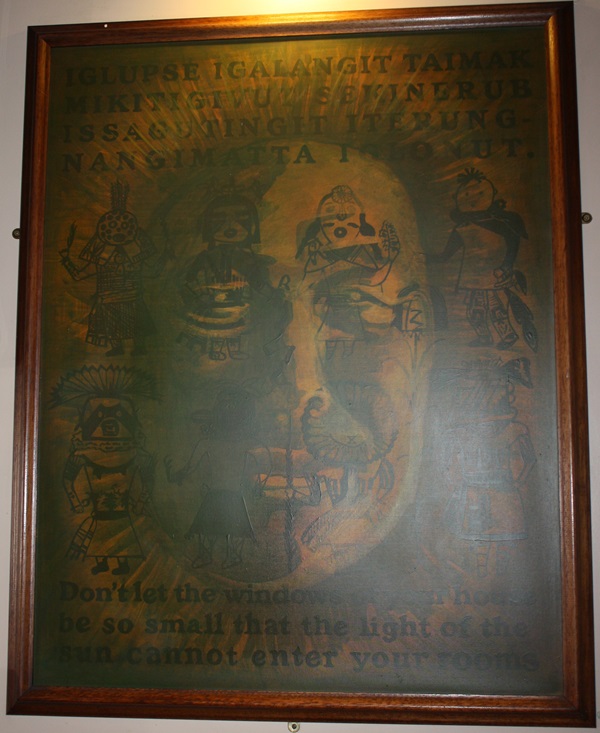
An external view of the pub – main entrance.

If you have information on the history of this pub, then we’d like you to share it with us. Please e-mail all information to: pubhistories@jdwetherspoon.co.uk